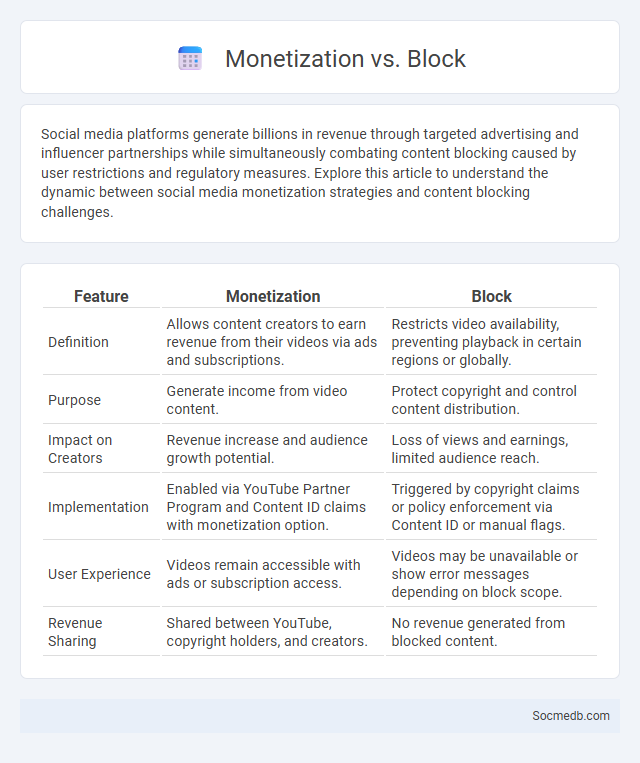
Photo illustration: Monetization vs Block
Social media platforms generate billions in revenue through targeted advertising and influencer partnerships while simultaneously combating content blocking caused by user restrictions and regulatory measures. Explore this article to understand the dynamic between social media monetization strategies and content blocking challenges.
Table of Comparison
| Feature | Monetization | Block |
|---|---|---|
| Definition | Allows content creators to earn revenue from their videos via ads and subscriptions. | Restricts video availability, preventing playback in certain regions or globally. |
| Purpose | Generate income from video content. | Protect copyright and control content distribution. |
| Impact on Creators | Revenue increase and audience growth potential. | Loss of views and earnings, limited audience reach. |
| Implementation | Enabled via YouTube Partner Program and Content ID claims with monetization option. | Triggered by copyright claims or policy enforcement via Content ID or manual flags. |
| User Experience | Videos remain accessible with ads or subscription access. | Videos may be unavailable or show error messages depending on block scope. |
| Revenue Sharing | Shared between YouTube, copyright holders, and creators. | No revenue generated from blocked content. |
Understanding Monetization: What It Means for Creators
Monetization on social media refers to the process by which creators earn revenue from their content through various methods such as ad revenue sharing, sponsored posts, affiliate marketing, and fan subscriptions. Platforms like YouTube, Instagram, and TikTok offer specific monetization features including YouTube's Partner Program, Instagram's branded content tools, and TikTok's Creator Fund, enabling creators to transform their audience engagement into income streams. Understanding these monetization mechanisms allows creators to optimize content strategies, maximize earnings, and build sustainable digital careers.
How Copyright Claims Impact Your Content
Copyright claims on social media can limit the reach and visibility of your content by restricting its distribution or causing removal from platforms. These claims may result in penalties such as muted audio, blocked videos, or account strikes that affect your overall engagement. Understanding the nuances of copyright law and using original or licensed materials protects your content and maintains your online presence effectively.
The Consequences of a Content Block
Content blocks on social media can severely restrict your digital presence and limit audience engagement, leading to decreased visibility and potential loss of followers. Algorithms often reduce the reach of accounts that experience frequent blocks, impacting brand growth and influence. Understanding the consequences of a content block helps you avoid penalties and maintain consistent interaction with your target audience.
Differences Between Copyright Claims, Blocks, and Monetization
Copyright claims on social media identify unauthorized use of protected content without removing the post, whereas blocks restrict access by preventing the content from being viewed altogether. Monetization involves rights holders allowing the use of their copyrighted material in exchange for revenue sharing, often through ads displayed on the content. Understanding these distinctions helps content creators navigate platform policies, protect intellectual property, and optimize earnings.
YouTube’s Content ID System Explained
YouTube's Content ID system is an advanced digital fingerprinting technology used to identify and manage copyrighted material across the platform. It scans uploaded videos against a vast database of registered content, allowing copyright holders to monetize, block, or track unauthorized use. This automated system plays a critical role in protecting intellectual property rights while supporting creators and copyright owners.
Revenue Sharing in Monetized Copyright Claims
Revenue sharing in monetized copyright claims allows content creators to earn a portion of the ad revenue generated from videos featuring their copyrighted material on social media platforms like YouTube and Facebook. Your ability to monetize these claims depends on the platform's copyright policies and the rights holder's preferences, often resulting in a split of revenue between the creator, copyright owner, and platform. Understanding how automated copyright detection systems work ensures you can maximize earnings from your original or licensed content without risking takedowns.
Strategies to Avoid Copyright Strikes and Blocks
Implementing clear content creation guidelines that emphasize original work and proper attribution significantly reduces the risk of copyright strikes on social media platforms. Utilizing licensed content libraries and tools such as Content ID matches helps identify potential infringements before posting. Regularly reviewing platform-specific copyright policies and employing digital rights management software protect social media accounts from blocks and ensure compliance with intellectual property laws.
Navigating the Dispute Process for Claims and Blocks
Navigating the dispute process for social media claims and blocks involves understanding platform-specific policies and providing clear evidence to support your case. Timely submission of appeal forms, detailed explanations, and adherence to community guidelines can significantly improve the chances of a successful resolution. Monitoring status updates closely helps users respond promptly to any additional information requests or procedural steps.
Legal Implications of Copyrighted Content Use
Using copyrighted content on social media without proper authorization can lead to legal consequences including takedown notices, fines, and potential lawsuits. Platforms like Facebook, Instagram, and YouTube employ automated systems to detect violations of intellectual property rights, which can result in account suspensions or content removal. Protecting your brand requires understanding fair use policies and obtaining licenses to avoid infringing on copyrights when sharing content.
Best Practices for Safe and Successful Monetization
Effective social media monetization involves building authentic engagement by providing valuable, niche-specific content that attracts and retains a loyal audience. Ensuring compliance with platform policies and transparent disclosure of sponsored partnerships protects brand reputation and avoids account penalties. Utilizing analytics tools to track performance and adapt strategies maximizes revenue potential while maintaining audience trust.
 socmedb.com
socmedb.com